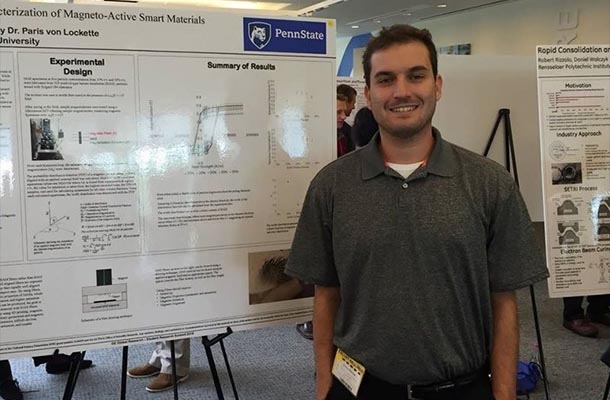
Corey Breznak presents his research at a poster session at Penn State University Park. IMAGE: PENN STATE
Graduate student to broaden impact, applications of magnetic 3D printing
Mechanical engineering's Corey Breznak was awarded the 2020 AT&T Graduate Fellowship to explore electromagnetically sensitive 3D-printed components
3/31/2020
By Erin Cassidy Hendrick
UNIVERSITY PARK, Pa. — Corey Breznak, a doctoral student in the Penn State Department of Mechanical Engineering, has been awarded the 2020 AT&T Graduate Fellowship.
Breznak works under his adviser, Paris von Lockette, associate professor of mechanical engineering, in the Magneto-Active Composites and Structures Lab (MACS), where researchers are developing fundamental insights to enhance the materials used for 3D printing.
As 3D printing inspires a new era of manufacturing, researchers in MACS contribute by broadening the knowledge of the material properties themselves, to enhance the overall impact of the technology.
The AT&T fellowship provides funding and recognition to outstanding graduate students conducting research with wireless data applications. Breznak is exploring the use of magnetic particles for wireless part identification and structural health monitoring in 3D-printed components.
With the support of this fellowship, Breznak will study the integration of a magnetic filament embedded within 3D-printed parts. By determining their unique electromagnetic signatures, the inclusion of these materials will allow for information about the part to be transmitted wirelessly. The notion is similar to a bar or QR code, but this novel method uses magnetic fields instead of visual cues.
These magnetic patterns will allow for the data to be hidden from the naked eye, allowing manufacturers full control over the aesthetics of their product and makes the information less susceptible to damage.
In addition, the filaments pose a unique opportunity to monitor the structural health of the piece. As the component changes in shape and density through continual use, Breznak theorizes the magnetic fields will change in tandem.
“This information will allow people to look at how something deforms when there is stress applied to it,” he said. “There is a lot of interest from industry to be able to monitor these parts in a nondestructive way.”
For instance, a metal part used within heavy machinery could be more accurately monitored and replaced exactly when it needs to be, rather than relying on estimates or a coarse approximation of damage seen from the outside.
“This could be very useful for any company that has been manufacturing using 3D printing,” he said. “The key feature is that you are embedding this technology when the part is being created, instead of post-processing it.”
Breznak said in this nascent research area, there is still much to uncover. Adding to that knowledge is what inspires him to continue.
“In our department, we have strengths in so many core mechanical engineering topics like thermal and mechanical sciences,” he said. “But I like that magnetics aren’t a traditional research area for the field, it’s something I can add to.”
He also finds contributing to the University’s growing level of expertise in 3D printing a worthy pursuit.
“The fact is, 3D printing is becoming a new way of life for manufacturing and magnetic materials aren’t really being used right now, so this is where I can help bring that in,” Breznak said.



